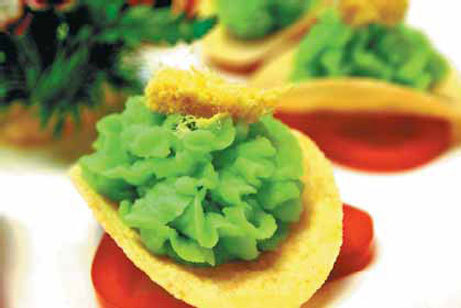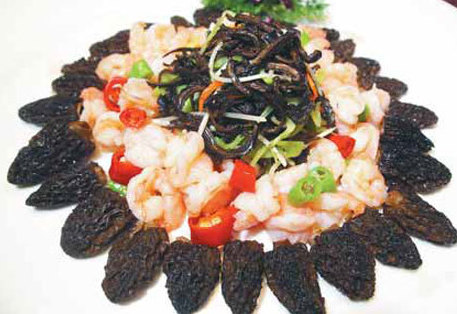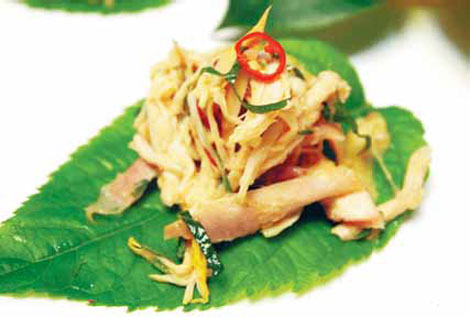Tribal & Earthy
Updated: 2012-05-13 07:50
By Pauline D. Loh(China Daily)
|
|||||||||
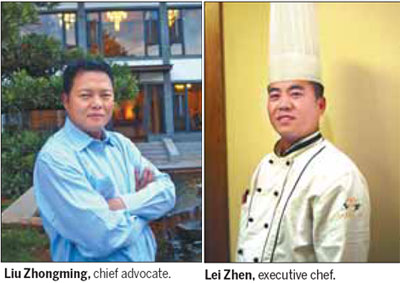
|
The neon-green puree of Chinese (or mountain) yam, flavored and colored with fresh spinach juice, is served on a Pringle chip. Photos by Pauline D. Loh / China Daily |
|
A platter of whole black morels, glistening pink prawns and deep dark chocolate-colored strips of "tiger paw mushrooms" represents all the earthy goodness of Yunnan produce. |
|
An appetizer of cold shredded chicken salad served on fresh duzhong leaves. |
Dian cuisine ranks among China's major epicurean styles, but few truly understand what it is all about. Pauline D. Loh finds out what's in the melting pot.
Yunnan province spreads across a rich tapestry of geological and climatic diversity in southwest China. In the north, the Tibetan foothills nurture alpine vineyards that are beginning to be known for cool climate grape varieties like Riesling, harvested and pressed in winter for the country's best-tasting icewine.
In the south, the exotic rainforests of Xishuangbanna produce rubber, bananas, mangoes and huge banyan trees that dwarf tribal villages.
And in between, the Guizhou-Yunnan highlands provide a mild and protected terroir that allows Kunming to blossom as a City of Eternal Spring.
Little wonder then that Yunnan or "Dian" cuisine (after the province's ancient name), draws inspiration from the natural bounty of the land, including the country's best crops of wild fungi and mushrooms, herbs and flowers.
In Kunming, the provincial capital, the World Expo Garden is a botanical showcase currently bright with seasonal carpets of red and gold poppies.
Hidden in the huge park is a private clubhouse housing an excellent restaurant that is open to the public.
It is here that I get to ask the questions that have piqued my curiosity for so long. What constitutes Yunnan cuisine and what makes it different from the other Chinese styles of cooking?
Liu Zhongming is the man in charge, a fully trained chef and the influential head of the provincial restaurant association.
He is also a firm believer in the maxim: Food is medicine, medicine is food, and upon that conviction, he has successfully built an extremely well-received menu at one of his three restaurants, the World Expo Garden Eco-Wellness Culinary Club.
Liu is enthusiastic and passionate about his craft and most of all, eager to build upon his base of traditional Yunnan cooking to create innovative dishes that appeal to the healthier lifestyle demands of today's Chinese urbanites.
Trained in Dian cuisine but also in the traditional "Xiang" or Hunan-style cooking, Liu has now turned his attention to the native cornucopia of Yunnan, and he seemed the best person to ask for that elusive definition of what it's all about.
"Dian cuisine is all about heat from good chili, with plenty of fresh herbal seasoning. It's about the freshest ingredients that go into signature classics such as the qiguo chicken, and our famous rice noodles."
Qiguo chicken is chicken cooked in a special clay pot with an internal funnel that captures the essence of the bird as it braises in its own juices.
Classic ingredients that go into the dish are the native black silky chicken, accompanied by herbs such as wolfberries and sanqi or panax ginseng.
The rice noodles dish Yunnan is most famous for originates from Mengzi in Honghe prefecture, where it was invented by an anxious wife eager to serve her husband a hot bowl of noodles while he slogged for imperial examinations.
She made a bowl of chicken soup smothered in a layer of oil that kept the broth simmering hot while she carried it to his study. The hot soup was then poured over a platter of rice noodles. Since her journey took her over a bridge, it became known as Over The Bridge Rice Noodles to commemorate her wifely devotion.
But Yunnan cuisine is also much more than just two dishes, Liu says. Of China's 56 ethnic groups, 27 are well-represented in Yunnan's harmonious melting pot.
The tribal kitchens of these colorful ethnic groups have greatly influenced Dian cuisine.
Fresh herbs, exotic ingredients from paddock and rice fields and foraged wild vegetables all form a large part of the culinary mise en place, and almost all these simple home chefs have never even heard of Slow Food although they have been practicing its principles for countless generations.
The last epicurean attraction that is uniquely Yunnan's is, of course, its huge trove of wild mushrooms and fungi, including black truffles, Matsutake mushrooms, chanterelles, morels and other lesser-known varieties.
For Liu and his executive chef Lei Zhen, the healthy, medicinal benefits of eating fresh and eating local are the main attractions that draw in an exclusive clientele.
The restaurant ambience says it all.
Tasteful antiques and calligraphy scrolls line the hallway where diners can relax with a pre-dinner cup of tea served by smiling wait staff who can also give you a quick lesson on the different teas on offer.
Yunnan, after all, is the home of tea.
Dinner is served in an annex in the courtyard where carved stone water features provide an expanse liquid, musical trickles.
The entrance to the dining hall has a shrine honoring Li Shizhen, the father of traditional Chinese medicine and author of a medical compendium still referred to by modern practitioners.
The banquet that follows is a visual treat and throws up surprises even for jaded gourmets.
First up is an appetizer of cold shredded chicken salad served on fresh duzhong leaves. This is a species of Eucommia, a tree that loves the mild climate of Yunnan.
The bark is dried and used to treat "weak backs", an euphemism for compromised male virility.
Here, Liu says, the leaves are harvested from a tree in the herbal garden that the chefs maintain for the kitchens.
The duzhong leaves are reminiscent of the light fragrance of perilla leaves, and lifts the richness of the chicken and its complimentary herbal dressing.
Next up is an almost neon-green puree of Chinese (or mountain) yam, flavored and colored with fresh spinach juice and served on a Pringle chip.
It made me smile, that potato chip, and I am just wondering if those people who make Pringles realize what an inventive use Chinese chefs have found for their humble crisp.
The serious meats arrived in succession, among which was the classic qiguo dish. But this was cooked with swan meat, paired with generous helpings of black truffles.
Liu hastens to assure the sentimental females around the table that it was farm-bred swan, specially raised for meat, like geese or turkey.
Nevertheless, I was only glad the menu did not include more exotic offerings like peacock or peahen, Yunnan's iconic bird.
While we politely sipped at the swan soup, the next dish that arrived had us sitting up and reaching for our cameras.
It was a beautiful platter of whole black morels, glistening pink prawns and again, deep dark chocolate-colored strips of yet another intensely fragrant mushroom that we were told were "tiger paw mushrooms".
While the morels were acknowledged as highly valued for their delightful fragrance and texture, it was the rare tiger paws that drew the most questions.
This is a unique fungus that grows in many regions in China, but although its geographical spread is wide, it is as rare as the Perigord truffles and even harder to find.
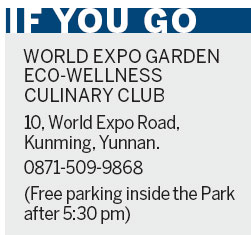
It is most often sold in a dried form, and the mushroom must be huge because even when dried, it is fully the size of a man's palm, or as its name suggests, a tiger's paw.
Yunnan cuisine is indeed varied and full of surprises.
And the loveliest surprise of all at the club? I did not encounter a single Sichuan peppercorn, the palate-numbing, taste bud anesthetizing spice that has invaded so many of China's regional dishes.
With people like Liu and his chefs helming the Yunnan cuisine revolution, this is going to be the next Great Chinese Cuisine.
Already, in major metropolises such as Beijing and Shanghai, the trendiest new restaurants come from the Land South of the Colored Clouds.
Contact the writer at paulined@chinadaily.com.cn.
(China Daily 05/13/2012 page14)
